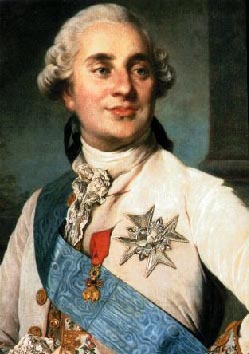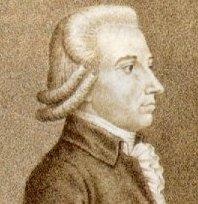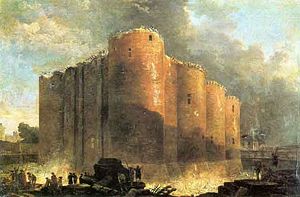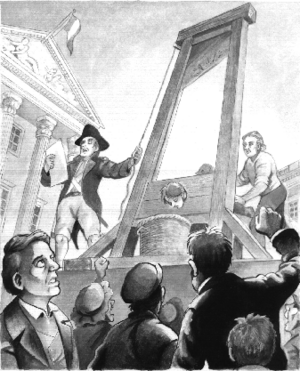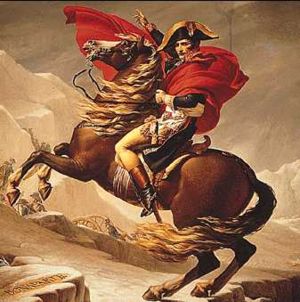French Revolution Timeline
From ThePlaz.com
The French Revolution Timeline - Western Civ Project
A Microsoft Word version of this work is available here: Image:French Revolution Descriptions After Grade.doc
![]() A PDF version of this work is available here: Image:French Revolution Descriptions After Grade.pdf
A PDF version of this work is available here: Image:French Revolution Descriptions After Grade.pdf
Excel File Showing Actual Timeline
May 10, 1774 - Louis XVI made King
King Louis the 16th became king in 1774. He was a weak leader and had trouble making decisions. Also, his wife, Marie Antoinette was despised by the French people because she came from long-hated Austria. She also spent money like crazy while the price of bread rose above the means of the people.
King Louis also created a lot of debt by helping the Americans beat long-time French enemy, Britain. In 1786, the banks refused to lend the king any more money causing the government to have serious troubles. Louis then called a meeting of the Estates-General to try and solve the money problem. Unfortunately this bad decision, along with the others he made, set the road to the French Revolution.
June 20, 1789 - Tennis Court Oath
When the Estates-General met, the third estate, in which 98% percent of the French citizens lived, demanded equal representation and taxation. Abbé Sieyès lead the revolt saying, “What is the Third Estate? Everything. What has it been in political order? Nothing. What does it demand? To be something herein.” Abbé led the delegates to have more influence and to be called the National Assembly. Three days later, they were locked out of their meeting room and met on a handball court to pronounce their Tennis Court Oath saying that they would end the absolute monarchy in France and write a new constitution.
This was the first deliberate act of revolution against the king. The Third Estate stood up against the Old Regime and declared an end to the absolute power of the monarchy. They were spreading the Enlightenment ideals that people can govern themselves and reforms are enacted in the name of the people. They were proactive in seeking a change of government.
July 14, 1789 - Storming of the Bastille
Louis XVI faced the new Assembly and did not know what to do, as usual. Because he no longer trusted the French soldiers to be loyal, he hired Swiss mercenaries to guard Paris. The citizens were scared of the Swiss soldiers and attacked the Bastille, where the gunpowder for the city was stored. The prison was defeated, but the mercenaries never came.
The fall of the Bastille, also the political prison, was a shot against the king. It has become the greatest symbolic act of the French Revolution. Today, July 14 is a national holiday in France. The fall of the Bastille also inspired women to walk ten miles to the king’s palace, Versailles. The women took the king from his magnificent palace to Paris, where he would stay forever. Also, peasants all over the countryside tore up old feudal papers and attacked nobles. This wave of revolution was called the Great Fear, as the peasants thought the nobles would send troops to attack them and the peasants were starting to fill their heads with revolutionary fever.
August 27, 1789 - Dec. of Rights of Man
A Declaration of the Rights of Man and the Citizen was passed by the National Assembly. All day in the National Assembly, nobles pronounced their support of liberty, equality, and fraternity (the slogan of the revolution). The nobles were forced to give up their special privileges from the Old Regime. This statement of revolutionary ideals gave all people the promise of the protection of their natural rights. It also granted all men the right to equal justice, freedom of speech, and freedom of religion.
This document granted essential natural rights to all men. It was made up of mostly Enlightenment ideas. This set the tone of the revolution. This was the starting point on the road, with even more reforms building up later on.
October 1, 1791 - Legislative Assembly Created
The National Assembly had finished the constitution and had Louis XVI sign it. The National Assembly then disbanded and created the Legislative Assembly. This new assembly had the power to make laws and declare war on other nations. The new assembly soon split as some people wanted more freedom or liberties.
This split in the Legislative Assembly helped prolong the revolution. France could not decide if they should keep granting new freedoms after limiting the king’s power. Radicals wanted to set up a democracy and conservatives wanted to keep the current limited monarchy. This split in different directions weakened the revolution because leaders could not decide where it was headed. This caused internal weakness and allowed other countries to attack and set up internal conflicts.
April 1792 - September 1792 - War with Austria
Austria and Prussia wanted King Louis XVI back on the throne. They were worried the revolutionary fever might spread to their countries and replace their absolute monarchies with democracies. The war started badly with the poorly equipped rebel-French soldiers not able to beat the Prussians. When the Prussian commander said he would attack Paris if the royal family was harmed, a mob stormed the palace in Paris where the king was staying.
King Louis was locked up in a stone tower. These attacks brought confusion to the city. There were rumors that royalists would capture the city with the soldiers gone. Mobs murdered many prisoners during the September massacre. These events led the Legislative Assembly to disband, and the National Convention started writing a new, second constitution for a republic. The French soldiers won a battle and the dangers from abroad retreated.
January 21, 1793 - King Executed
The mobs on the street ran around wild after the war with Austria. They had more power then any government assembly. Many clubs formed to give speeches and demand a republic and more freedoms. One of the more radicals clubs was the Jacobin Club. They called for the execution of the king. They successfully found him guilty of treason to the National Convention, the government at that time. He was executed with a guillotine.
The execution of the king was a final blow to the royalists. The king was not coming back anymore. The radicals had succeeded in getting rid of a monarchy. Also the political clubs tried to remove each other and install their leaders or favorite forms of government. This caused further internal conflict and weakness.
July 1763-July 28, 1794 - Robespierre's Reign of Terror
Maximilien Robespierre, the leader of the Jacobin Club, became the head of the Committee of Public Safety for the National Convention. In this role, he was free to decide who France’s enemies were. Some of these people were revolutionary leaders who challenged his leadership. Other people were killed for petty things. This fear of execution was called the Reign of Terror. No one was safe from Robespierre, as he ruled like a dictator in France. On July 28, 1974 they finally executed him and brought peace to Paris.
Everyone was scared by the Reign of Terror. 3,000 people were executed, most of them normal folks and supporters of the original revolution. The price of bread skyrocketed to all time highs. People were tired of the insecurities of democratic government. They wanted more stability and firm rulers.
November 2, 1795 - The Directory in Power
These new rulers were called the Directory. There were five leaders that ruled together and shared power. They were moderates not radicals. Some of them were corrupt, but gave a troubled country of period of order. When this new form of government was started, a new, third constitution was written.
The Directory made the country stable again and ruled for about five years till Napoleon forced them out. They provided a break from the democratic ideas that did not work. By 1799, the Directory lost the confidence of the French people. They voted them out of office, but the army kept them in control. That changed when Napoleon was put in charge of the army on November 9th.
November 10, 1799 - Napoleon appointed First Consul
Napoleon Bonaparte was a military genius who defended the National Convention against royalists, and led successful campaigns into Italy. He then began to grow hungry for more power. His wife and he worked over all of the important people in Paris. On November 10, the assembly made him first consul by passing the fourth constitution in eight years. A plebiscite, or vote by the people approved his role and the forth constitution in eight years.
Napoleon did a lot to change France. He ended the unstable revolution and provided a new, stable government. He also was involved in many military campaigns. Over all, he was so-so, but he did provide an end to the bloody revolution that ended up in a long killing spree for power. The revolution certainly ended a long way from liberty, equality, and fraternity.
Terms and Names
- Estates-General – An assembly of representatives from all of the Estates. Each estate met separately and got one vote. This method favored the nobility. King Louis XVI called the Estates-General together for the first time in 175 years to talk about the government’s money problems.
- National Assembly – Abbé Sieyès led the third estate to separate and pass laws in the name of the French people. This legislator they started was called the National Assembly. They swept away feudal privileges, gave people rights, and limited the king’s power thought the first constitution.
- Tennis Court Oath – Abbé Sieyès and the Third Estate, after being locked out of their meeting hall, met on a handball court. They promised to stick together to create the National Assembly. This promise was called the Tennis Court Oath.
- Old Regime – The old system of doing things in France. There were 3 estates or classes. The first estate contained the church officials. The second estate contained the nobility. The third estate included the commoners.
- Great Fear – A wave of panic throughout the country side when peasants thought foreigners were coming to attack. They turned their anger towards the nobles and destroyed old feudal papers forcing them to work.
- Declaration of the Rights of Man – A document created by the National Assembly that promised all men many natural rights. These included liberty, property and security from oppression, as well as equal justice, and freedom of speech and religion. It stated that all men were equal.
- Legislative Assembly – Another legislature set up by the National Assembly after they wrote the first constitution. This assembly had the power to make laws and declare war. This legislator was divided up into three groups that pulled the country in different directions.
- Jacobin Club – A radical political club with Maximilien Robespierre as it’s leader. They wanted to set up a republic and execute the king. They were successful in both accounts. They made violent speeches and rid France of most of their enemies during the reign of terror.
- Guillotine – A device invented by Dr. Joseph Ignace Guillotin. It was intended to painlessly cut off prisoners head’s. It was used to execute thousands of people during the French Revolution.
- Maximilien Robespierre – A revolutionary leader and member of the Jacobin Club. He became the leader of the Committee of Public Safety and led as a dictator. He killed thousands of people during the Reign of Terror.
- Reign of Terror – A period during the French Revolution when Maximilien Robespierre was the leader. Many people were killed for petty reasons and a period of unrest followed. It happened during July 1763-July 28, 1794.
- Napoleon Bonaparte – A military leader and Emperor of France after the French Revolution. He saved the country from unrest and put it back on a stable ground. He led many military victories, but made many mistakes and killed many people.
